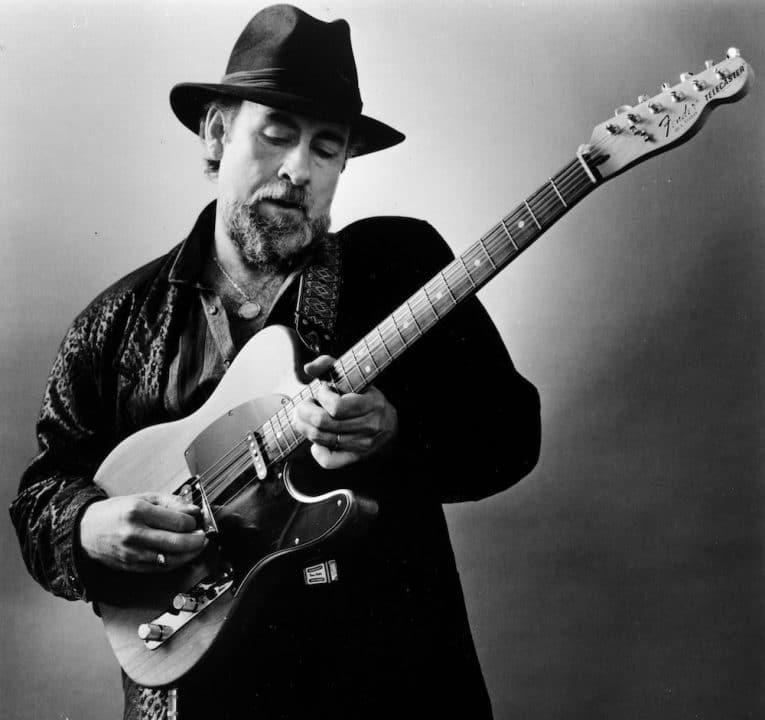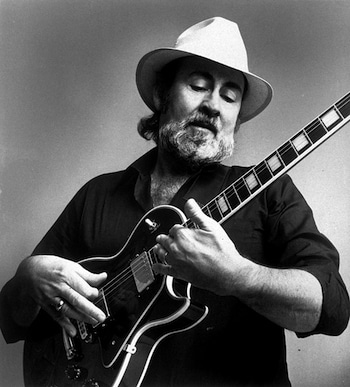
Photo: Paul Natkin, Alligator Records
By Mark Westin
Sit back, folks, and listen up. It’s time to give your respect to a titan of the Telecaster:
Mr. Roy Buchanan.
Here in the six-string universe, we all have that one cat who’s the man. The cat whose playing blows you away all the time, every time. The cat you raise your voice about when you’re hanging with other players at the bar. Sure, you got your top ten lists, and there are the ones you love just for a specific lick or tune, but when you get right down to it and have to choose the single most inspirational, gun-to-your-head, alone on a desert island, go-to musician who speaks directly to your soul, there’s always the cat you look at and say, “That’s the man!”
When I think of the man, I think of Roy Buchanan. And I’m not alone. Roy’s biographer Phil Carson says when Clapton heard Roy play, he called him “the best in the world.” There’s a well-worn rumor that the Stones hired Mick Taylor only after Roy turned them down. David Gilmour, Danny Gatton, Nils Lofgren, Robbie Robertson…the list of Roy’s disciples goes on.
Gary Moore, a guitarist’s guitarist, covered one of Roy’s signature tunes, “The Messiah Will Come Again”. Jeff Beck, the master of tone, taste and touch, dedicated “Cause We’ve Ended As Lovers” to him as a tribute, right there on the Blow by Blow album cover. Listen to these tracks after you’ve heard Roy, and his influence is crystal clear.
I found Roy, or maybe his music found me, while I was living in Washington D.C. for a couple years in the late ‘70s. It was fertile ground for blues of every stripe. The Nighthawks and George Thorogood gigged around on a regular basis. Danny Gatton was a hometown hero with monster chops, and Nils Lofgren had become a national star out of the local scene. Supporting it all was a great bunch of fans who truly loved real roots music.
And nobody was realer or rootsier than Roy. From the moment I first dropped the needle on Roy Buchanan’s Second Album (the first one I heard), I was blown away. At a time when the dominant players in my world were prog-rockers stomping effects boxes in front of Marshall stacks, I couldn’t believe the tone this man got with just a Telecaster, a little Fender amp and his fingers. Alternately clean and crunchy in all the right places, from chicken pickin’ to searing sustain. He could even mimic a wah pedal with just his hands and his volume knobs. I had a Tele too, but I couldn’t get that tone no matter how hard I tried.
After many attempts at copping Roy’s licks, I learned what’s turned out to be my most enduring music lesson: Be yourself. Every guitarist starts out emulating someone who came before, and many never get past that. They become reliable jukeboxes, playing the licks from the records but never putting their own stamp and stench on the songs. Sure, Roy was about notes and technical facility, but what set him apart from the pack was the depth of feeling he infused into his technique. If you want to understand what it means to speak in your own voice as a musician – not just as a guitarist – all I can say is: listen to Roy play “Hey Joe”.

Photo: Peter Amft, Alligator Records
There’s a deeply-rooted (in my mind) mistaken belief within the guitar community that certain artists have done such definitive versions of certain songs that there’s nothing more to be said. Hendrix’s version of “Hey Joe” is one. For better or worse, the song has been frozen in amber, Jimi’s fretwork analyzed, replicated and passed down through the years via books and cover bands and YouTube with no variation. And yet, Roy Buchanan, in the post-Hendrix 1970s, dared to take this iconic and untouchable piece of the guitar canon and make it his own.
First, his vocal take on the song doesn’t mimic Jimi. Roy’s phrasing is offhand, unaffected, almost a throwaway. Instead, Roy sings through his guitar.
He builds his musical story slowly, creates tension and release with dynamics, alternates delicate soft passages with blistering staccato arpeggios. Volume swells and fades, pinch harmonics, noise-as-melody and that pure, sweet tone reveal the many shades of Roy’s soul as the solo burns on.
Roy’s take on “Hey Joe” is fresh, it’s original, and it’s no less passionate than Hendrix at his most intense. And after six minutes of fretboard fireworks, just when you’re saying, “Jimi who?”, Roy drops in a tongue-in-cheek “Foxy Lady” coda as a playful but respectful acknowledgement of his predecessor.
If you’ve never dug into the Roy Buchanan catalog, just start at the beginning and work your way through. You’ll be rewarded with hours of listening pleasure and, especially in his live work, more than a few jaw-dropping moments of pure awe. His later life was marred by personal trials, and his untimely death in 1988 cut short a career that would have surely risen to greater heights. Still, his substantial recorded legacy lives on for all to hear and enjoy.
As Roy said in Introducing Roy Buchanan, the 1971 documentary about his life and music, “I think the reason I never made it big was because I didn’t care whether I made it big or not. All I wanted to do was learn to play the guitar for myself and I didn’t care about anybody else.” Maybe so, but lots of us ended up caring about him. To me, he’ll be forever the man.
For more information about Roy Buchanan:
Thanks to Marc Lipkin at Alligator Records for supplying the photos.

Great piece on a legend that many have never or will ever listen too in their lifetime. I’m just glad, I came across Roy’s work about 5 years ago and I hear him on my playlist all week long.
Roy is Amazing!!! His death was a horrible loss to the blues and music in general.
Great article! Good to see his name and reputation as one of the best guitarists ever live on.
Caught Roy’s gigs three times past.. LOVED every minute!
I did a short stint at the Town Hall in NYC in the early ’70’s and was working the Buchanan shows which wound up on a later album. I knew his name but hadn’t heard the man play.
Then he played.
Much like BC and AD is to measuring time there is before Buchanan and after Buchanan to measure blues rock guitar gods.
there was roy then the rest , best tone and picking I ever heard